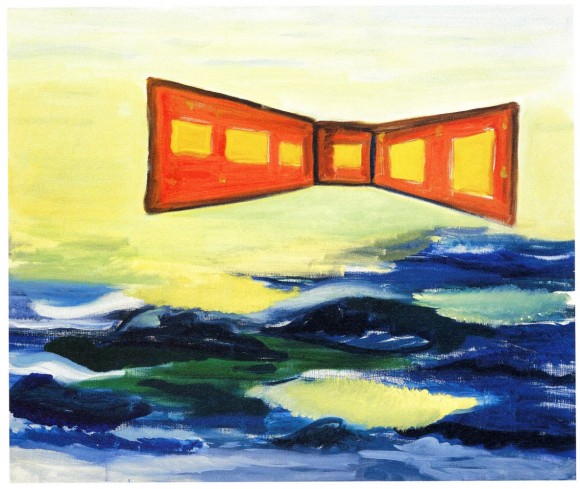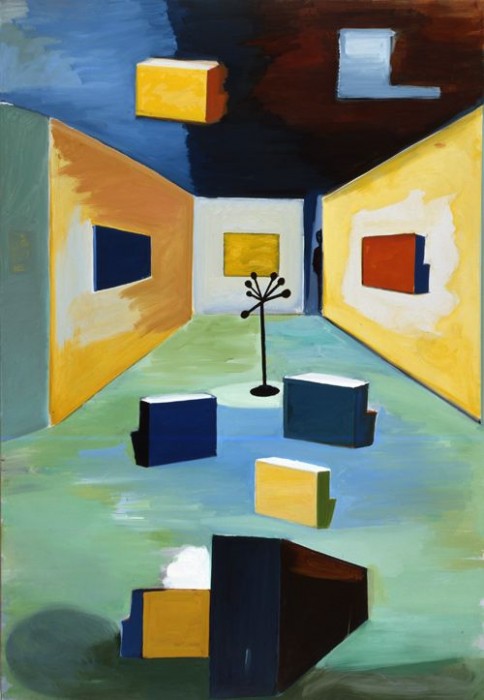
René Daniëls, "De Slag om de Twintigste Eeuw (Battle for the Twentieth Century)," 1984. Courtesy ABN AMRO Collection.
René Daniëls is a really, really good painter, maybe even a great painter, who stopped painting twenty-three years ago and has only resumed in the last two years. In 1987, he suffered a brain aneurysm from which he still hasn’t fully recovered, and some of his recent work, shown alongside his ’80s painting in the current show at the Camden Arts Centre, has a tentativeness you might expect from someone gradually returning to a loved activity. What must it be like for Daniëls, seeing his earlier paintings – richly colored, exuberant, mischievous oils – laid out here, with his more recent pieces – small-scale, scrawly felt-tip revivals of earlier motifs – dotted among them? It’s a reminder, at least, that for an artist, the past is always present, like a rebuke.
What makes Daniëls’s sudden halt so moving – and his current return so heartening, and quietly triumphant – is the sheer blazing visual excitement his paintings release. Daniëls is, first and foremost, a whipper-upper of retinal delight. His 1987 painting, The Return of the Performance, is a case in point. A zoomingly recessive perspectival space (a sort of three-walled room, like a stage set, that sometimes detaches itself from illustration and becomes, in other works, a kind of levitating bow-tie) creates a setting for the display of primary colored boxes and planes, like a painting of a Donald Judd installation made in enthusiastic recall. Paint slips and slides across the surfaces of things, just describing enough, never telling everything. In the center, a microphone stand with seven protruberances stands in a pool of milky light, and a figure peers in shadow from behind a wall, as if preparing to make a speech. The theme of performance recurs in Daniëls’s work (when human presences appear, they’re theatrical, dandyish flaneurs, as in his Cocoanuts of 1982), and the paintings themselves feel psyched-up-for, generated by nervy energy and stage fright.

Rene Daniëls, "De Terugkeer Van De Performance (The Return of the Performance)," 1987. Private collection.
And yet there’s caution, too, in Daniëls’s paintings. This links him to his native Dutch tradition of Mondrian and van Doesburg – those planes of bright primary color could be flatpack De Stijl furniture, pre-assembly – and, even further back, to the tensed interiors of de Hooch and Vermeer. (It’s worth mentioning that, as part of their Most Wanted Paintings project — in which they polled various countries on their most desired kind of painting — Russian art pranksters Komar and Melamid discovered that Holland was the only country to opt for an abstraction). There’s a quiet bloody-mindedness there that might account for Daniëls’s relatively unsung appearance in the brawny ’80s New York art world of Salle, Schnabel, and Basquiat in which he first appeared. He doesn’t sit right, the dude who won’t dance at the party.
Daniëls’s colorist energy is perpetually tempered by restrained formal devices and structures, and one of the joys of his work is this frisson between the introvert and extrovert. His works channel the brittle, elegant energy of the best music of his time – post-punk bands like Talking Heads, Gang of Four, or PiL – whose sound, like Daniëls’s aesthetic, found itself regurgitated in the late ’90s (Strokes/Doig; Interpol/Dumas; Tuymans/Franz Ferdinand; discuss). And that budding mike stand recurs as a standalone motif in a number of works, scrawled on with lists, days of the week, descriptions of locations. And yet it’s not its reference to an amplification the works themselves coyly shy away from that really provides the key to the reserved charm of Daniëls’s work. It’s in their perhaps unwitting reference to Darwin’s extraordinary 1837 sketch of the evolutionary tree, a sort of rehearsal for On the Origin of Species. Above it, floating at the top edge of the notebook page, is written, with a combination of reticence and force, “I think.”

Charles Darwin's 1837 notebook




Pingback: René Daniëls | Art Matters!